Superior Protection&Faster Decomposition & Cost Savings – Food-Grade Sustainable Packaging
Understanding Egg Containers: A Comprehensive Guide to Their Benefits and Varieties
12 Nov,2025
---
Egg containers, often referred to as egg cartons or trays, are essential in the packaging industry, particularly for the safe transport and storage of eggs. The primary purpose of these containers is to shield eggs from damage, prevent breakage, and maintain their freshness during transportation and storage. They come in various materials and designs, each tailored to meet specific needs in the packaging process.
One of the most common materials used for egg containers is paper-based products, especially molded fiber. Molded fiber egg cartons are not only cost-effective but also environmentally friendly, as they are made from recycled materials. These containers provide excellent cushioning and are designed to hold eggs securely, minimizing movement and reducing the risk of breakage. Additionally, they are biodegradable, making them a preferred choice for eco-conscious consumers and businesses.
Plastic egg containers are another popular option. They offer a higher level of durability and can be reused multiple times, making them suitable for businesses that require a more resilient solution. These containers often come with features such as snap-on lids for better sealing, which helps preserve the freshness of the eggs for longer periods. However, it is essential to consider the environmental impact of plastic, as it is not biodegradable and requires proper disposal methods.
When choosing an egg container, it’s important to consider the size and shape of the eggs being packaged. Standard containers typically hold a dozen eggs, but there are also options for smaller or larger quantities. Some manufacturers offer customizable solutions, allowing businesses to tailor the size and design of the containers to fit their specific products and branding needs.
In addition to functionality, the aesthetic appeal of egg containers can also play a significant role in attracting consumers. Packaging that features appealing designs or branding elements can enhance the overall presentation of the product, making it more marketable. Many businesses take advantage of printing options available on paper-based containers, allowing for colorful graphics and information that can catch a consumer’s eye.
In summary, egg containers are a vital component in the packaging industry, serving the dual purpose of protection and presentation. Whether opting for molded fiber or plastic options, understanding the unique benefits and limitations of each material can help businesses make informed decisions. By selecting the right egg container, companies can ensure that their products remain safe and appealing, ultimately contributing to their success in the market.
Egg containers, often referred to as egg cartons or trays, are essential in the packaging industry, particularly for the safe transport and storage of eggs. The primary purpose of these containers is to shield eggs from damage, prevent breakage, and maintain their freshness during transportation and storage. They come in various materials and designs, each tailored to meet specific needs in the packaging process.
One of the most common materials used for egg containers is paper-based products, especially molded fiber. Molded fiber egg cartons are not only cost-effective but also environmentally friendly, as they are made from recycled materials. These containers provide excellent cushioning and are designed to hold eggs securely, minimizing movement and reducing the risk of breakage. Additionally, they are biodegradable, making them a preferred choice for eco-conscious consumers and businesses.
Plastic egg containers are another popular option. They offer a higher level of durability and can be reused multiple times, making them suitable for businesses that require a more resilient solution. These containers often come with features such as snap-on lids for better sealing, which helps preserve the freshness of the eggs for longer periods. However, it is essential to consider the environmental impact of plastic, as it is not biodegradable and requires proper disposal methods.
When choosing an egg container, it’s important to consider the size and shape of the eggs being packaged. Standard containers typically hold a dozen eggs, but there are also options for smaller or larger quantities. Some manufacturers offer customizable solutions, allowing businesses to tailor the size and design of the containers to fit their specific products and branding needs.
In addition to functionality, the aesthetic appeal of egg containers can also play a significant role in attracting consumers. Packaging that features appealing designs or branding elements can enhance the overall presentation of the product, making it more marketable. Many businesses take advantage of printing options available on paper-based containers, allowing for colorful graphics and information that can catch a consumer’s eye.
In summary, egg containers are a vital component in the packaging industry, serving the dual purpose of protection and presentation. Whether opting for molded fiber or plastic options, understanding the unique benefits and limitations of each material can help businesses make informed decisions. By selecting the right egg container, companies can ensure that their products remain safe and appealing, ultimately contributing to their success in the market.
Previous
Recent Posts








